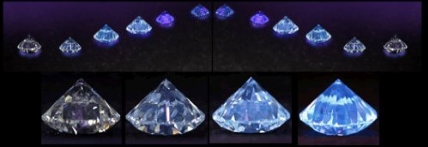All of us are inspired by the beauty of diamonds. These rare stones, mined from the very depths of the earth, are visually compelling. In general, diamonds are often considered devoid of intrinsic color. Their clarity is seen as the epitome of perfection. This is not a casual observation of the uninformed, but the sight of a well cut diamond set in an appropriate reflecting natural light that instills awe into most observers. The diamond is capable of a magnificent spectral display, due to natural scientific refraction of white light into its constituent ‘rainbow’ colors. In addition to this refraction, and the resulting myriad of color, there is another component: Fluorescence.
Color is just color right?
Well, sort of. Diamonds come in few colors; all of them are transparent so the refraction of light is maintained through the yellow/blue-tints found in some stones. In general diamonds are white (i.e. colorless). Regardless of their actual color, diamonds have fluorescent qualities. Fluorescence is a means by which the energy from an electromagnetic wave (i.e. light, in this discussion) is stored in a substance (i.e. a diamond) and re-transmitted at a different frequency. In layman’s terms, this means light hits a diamond and is re-emitted as a different light. This re-emitted light is called fluorescence. In diamonds the fluorescent emission is rated by examining experts and a part of the grading process. The internationally accepted grades are: inert, faint, medium, strong, very strong. These grading are self-explanatory but it is important to know these facts before fluorescence is considered as a purchase criteria;
· Diamonds do not all fluoresce. In fact only 35% do
· Of the 35%, most are blue-fluorescent (97%)
· Of the 3% that are not blue-fluorescent, green/Yellow/Red are potential colors, but many shades in-between are possible. These are rare and expensive stones. Professional advice should be sought when purchasing these stones as some can produce a milky (and unattractive) view when viewed under certain lights. These are named “overblues” and although rare, are not sought after.
· Strong blue fluorescence has the effect of yellow cancellation, so these stones produce a much more desirable visual spectrum. Yellow tinted stones which can fluoresce in blue can make an otherwise less attractive yellow diamond into a very pleasing gemstone.
Choose carefully…
Many fluorescent diamonds, especially when mounted in jewelry, exhibit dullness or cloudiness when viewed in certain background lights. When examining such stones, varying light sources including sunlight should be used, before a purchase is made. Diamond fluorescence is a complex science, but in the world of diamonds, a fairly straightforward quality grading process. At the end of the day, the ‘eye is in the beholder” – but note that the highly fluorescent diamond is not necessarily the best!

